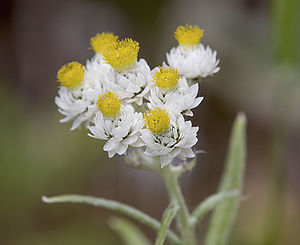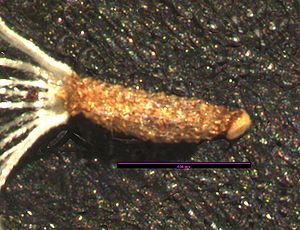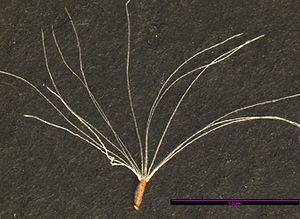Difference between revisions of "Anaphalis margaritacea"
(→Seed) (Tag: VisualEditor) |
(→Plant Description) (Tag: VisualEditor) |
||
| Line 24: | Line 24: | ||
===Plant Description=== | ===Plant Description=== | ||
Individual, erect, cottony stems grow 1-3 ft. tall and are often clumped together creating a bushy appearance. Narrow leaves are gray-green to woolly-white. Globular flowers are actually long-enduring, white, dry bracts arranged around a yellow center. Several evenly leafy woolly stems in a small patch are topped by a crowded, roundish cluster of flower heads with pearly-white bracts, sometimes with a dark spot at base of each outer bracts. | Individual, erect, cottony stems grow 1-3 ft. tall and are often clumped together creating a bushy appearance. Narrow leaves are gray-green to woolly-white. Globular flowers are actually long-enduring, white, dry bracts arranged around a yellow center. Several evenly leafy woolly stems in a small patch are topped by a crowded, roundish cluster of flower heads with pearly-white bracts, sometimes with a dark spot at base of each outer bracts. | ||
| − | The dried stalks with their pearly-white heads are attractive in floral arrangements. The pure white flower is commonly used in dried flower arrangements. Good dried flowers; food plant for Painted lady butterflies.<ref name=":0"> | + | The dried stalks with their pearly-white heads are attractive in floral arrangements. The pure white flower is commonly used in dried flower arrangements. Good dried flowers; food plant for Painted lady butterflies.<ref name=":0">Native Plants of North America.” Retrieved from https://www.wildflower.org/plants/result.php?id_plant=anma.</ref> |
===Bloom Period=== | ===Bloom Period=== | ||
| − | July through September.<ref name=":1">http://biology.burke.washington.edu/herbarium/imagecollection/taxon.php?Taxon=Anaphalis%20margaritacea</ref> | + | July through September.<ref name=":1">WTU Herbarium, Burke Museum, & University of |
| + | Washington. Retrieved from http://biology.burke.washington.edu/herbarium/imagecollection/taxon.php?Taxon=Anaphalis%20margaritacea</ref> | ||
===Distribution=== | ===Distribution=== | ||
Widely distributed throughout Washington; occurring throughout North America except for portions of Midwest and Southeast.<ref name=":1" /> | Widely distributed throughout Washington; occurring throughout North America except for portions of Midwest and Southeast.<ref name=":1" /> | ||
Revision as of 23:31, 11 March 2021
- Latin Name: Anaphalis margaritacea
- Family: Asteraceae
- Common Names: pearly everlasting
- Synonyms/Misapplications: Gnaphalium margaritaceum
- Codon: ANAMAR
| Anaphalis margaritacea | |
|---|---|

| |
| Photo by Rod Gilbert. Also featured on Main Page | |
| Scientific classification | |
| Kingdom: | Plantae |
| Subkingdom: | Tracheobionta |
| Phylum: | Spermatophyta |
| Subphylum: | Magnoliophyta |
| Class: | Magnoliopsida |
| Subclass: | Asteranae |
| Order: | Asterales |
| Family: | Asteraceae |
| Genus: | Anaphalis DC. |
| Species: | Anaphalis margaritacea (L.) Benth. |
Contents
Plant Description
Individual, erect, cottony stems grow 1-3 ft. tall and are often clumped together creating a bushy appearance. Narrow leaves are gray-green to woolly-white. Globular flowers are actually long-enduring, white, dry bracts arranged around a yellow center. Several evenly leafy woolly stems in a small patch are topped by a crowded, roundish cluster of flower heads with pearly-white bracts, sometimes with a dark spot at base of each outer bracts. The dried stalks with their pearly-white heads are attractive in floral arrangements. The pure white flower is commonly used in dried flower arrangements. Good dried flowers; food plant for Painted lady butterflies.[1]
Bloom Period
July through September.[2]
Distribution
Widely distributed throughout Washington; occurring throughout North America except for portions of Midwest and Southeast.[2]
Habitat
Dry to somewhat moist open areas, low to sub-alpine elevations.[2]
Uses
In folk medicine, it is used as a salve for burns. (Strickland)[1]
Propagation
[Propagation protocol from USDA NRCS]
Seed
Seed sample from 2010
Average Measurement: 0.6 x 0.2 x 0.2
Measurement Range: L: 0.4 - 0.75, W: 0.1 - 0.3, D: 0.1 - 0.3
Features
Shape: Seeds somewhat ribbed. Right above hilum, seed narrows considerably before flaring out again.
Color: Seed is brown. Hilum is glossy and puckered, lighter colored that rest of seed.
Additional Features: Pappus of downy white hairs significantly longer that seed itself.
Surface: Seed covered in clear globules and is slightly lustrous.
Could be confused with: Antennaria howellii
Latitudinal Cross Section: elliptical ![]()
Longitudinal Cross Section: elliptical ![]()
Photo Gallery
References
- ↑ 1.0 1.1 Native Plants of North America.” Retrieved from https://www.wildflower.org/plants/result.php?id_plant=anma.
- ↑ 2.0 2.1 2.2 WTU Herbarium, Burke Museum, & University of Washington. Retrieved from http://biology.burke.washington.edu/herbarium/imagecollection/taxon.php?Taxon=Anaphalis%20margaritacea




